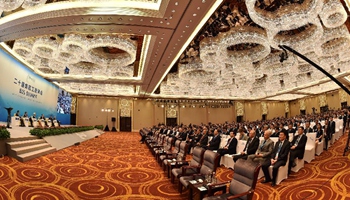WASHINGTON, Sept. 3 (Xinhua) -- Scientists at the Stanford University have developed a low-cost, plastic-based textile that, if woven into clothing, could make you feel super "cool."
This new material works because it can allow heat that the body emits as infrared radiation to escape as much as possible while blocking sunlight, they reported this week in the U.S. journal Science.
"This work is expected to usher in a new revolution in the garment industry," lead author Yi Cui, an associate professor of materials science and engineering and of photon science at Stanford, told Xinhua. "It also has the potential to result in a revolution in the energy industry."
Much of our body heat is lost in the form of infrared radiation, an invisible and benign wavelength of light. This thermal radiation is what makes us visible in the dark through night-vision goggles.
The new research explored whether polyethylene, the plastic we use as kitchen wrap, would allow thermal radiation to pass through. Of course, kitchen plastic is impervious to water and is see-through as well, rendering it useless as clothing.
Therefore, the Stanford researchers blended nanotechnology, photonics and chemistry to give polyethylene a number of new characteristics desirable in clothing material.
First, they found a variant of polyethylene commonly used in battery making that has a specific nanostructure that is opaque to visible light yet is transparent to infrared radiation, which could let body heat escape.
They then modified the industrial polyethylene by treating it with benign chemicals to enable water vapor molecules to evaporate through nanopores in the plastic, allowing the plastic to breathe like a natural fiber.
To make the resulting single-sheet material more fabric-like, they created a three-ply version: two sheets of treated polyethylene separated by a cotton mesh for strength and thickness.
To test the cooling potential of their three-ply construct versus a cotton fabric of comparable thickness, they placed a small swatch of each material on a surface that was as warm as bare skin and measured how much heat each material trapped.
The comparison showed that the cotton fabric made the skin surface 2.7 degrees Celsius warmer than their cooling textile.
The researchers said this difference means that a person dressed in their new material might feel less inclined to turn on a fan or air conditioner.
"If you can cool the person rather than the building where they work or live, that will save energy," said Cui.
The researchers said this work opens up new avenues of inquiry to cool or heat things, passively, without the use of outside energy, by tuning materials to dissipate or trap infrared radiation.
"In hindsight, some of what we've done looks very simple, but it's because few have really been looking at engineering the radiation characteristics of textiles," study author Shanhui Fan, a professor of electrical engineering at Stanford, added in a statement.










